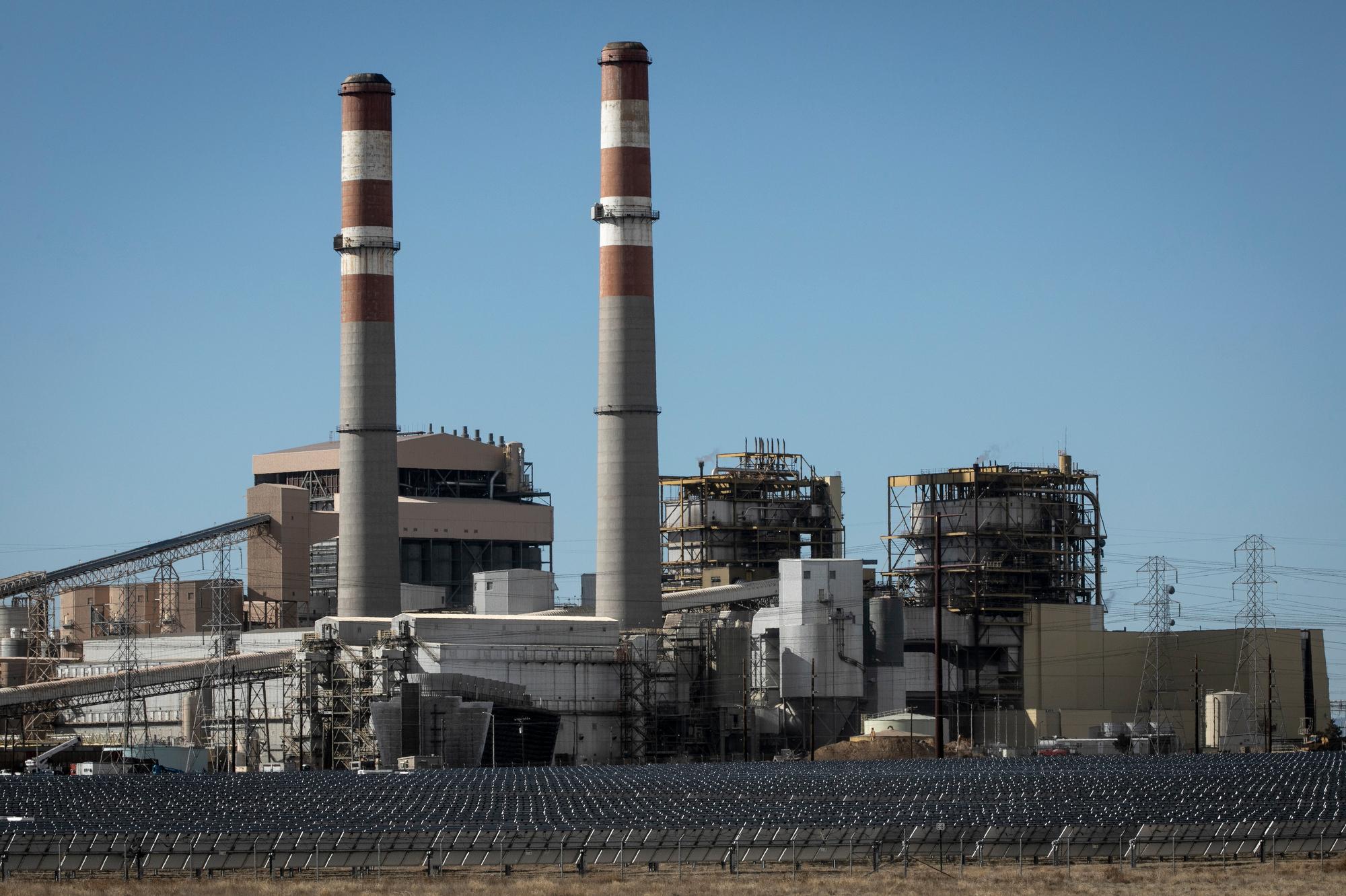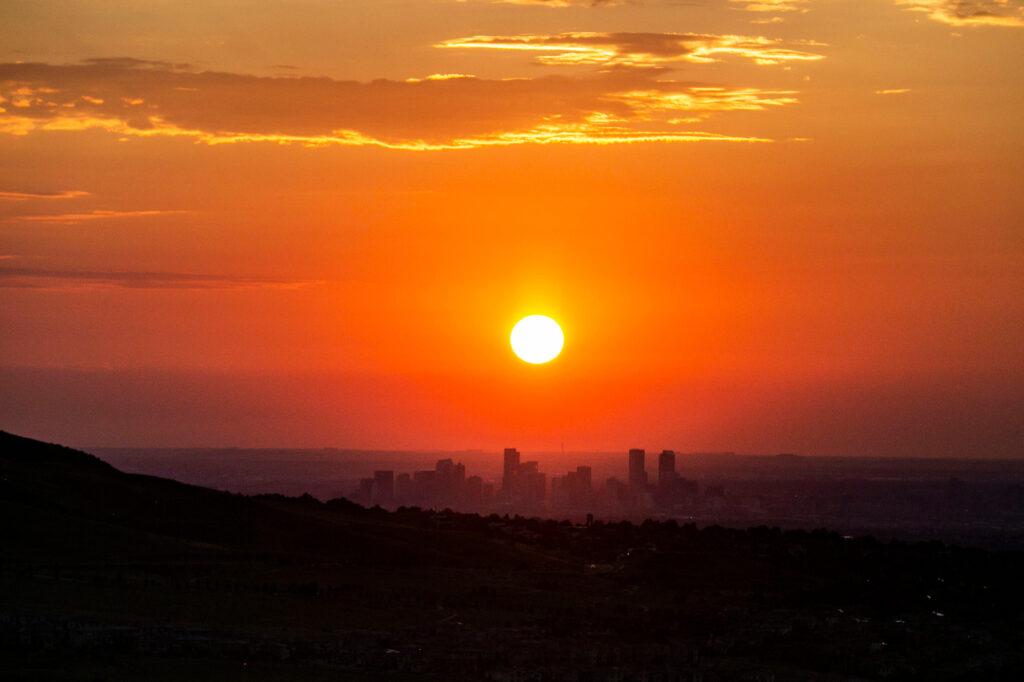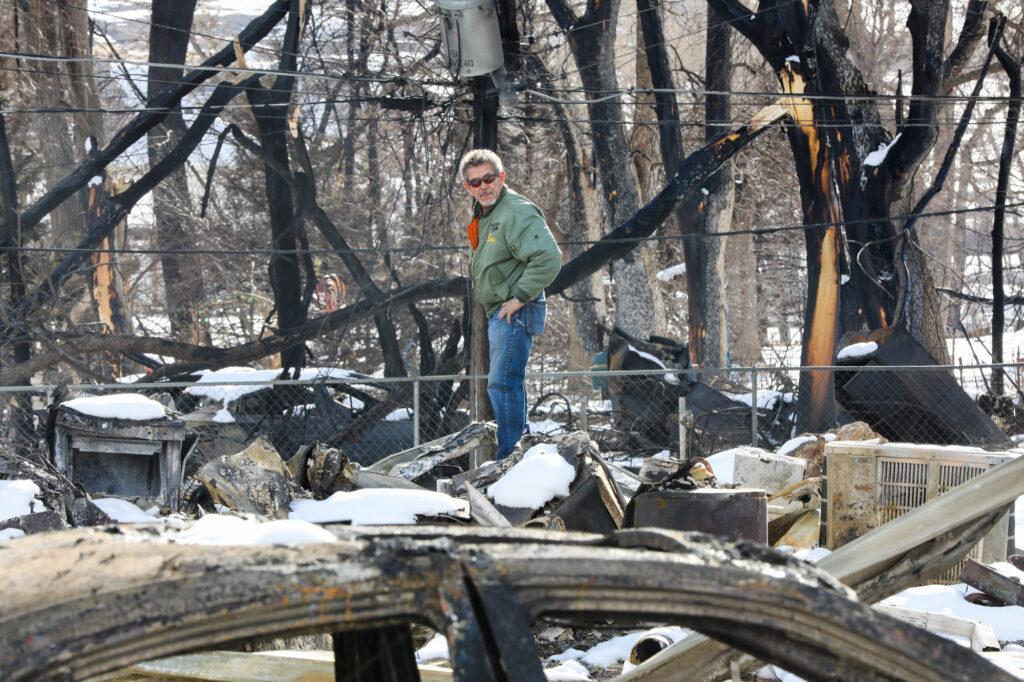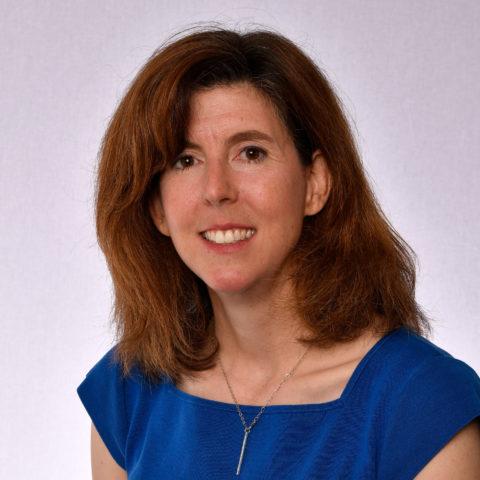
Xcel Energy customers have watched their utility bills skyrocket in the last few months — and costs aren't expected to stop climbing any time soon.
An electric rate hike went into effect last April after regulators agreed it would help Xcel Energy continue to supply reliable power. More recently, an administrative law judge ruled the company could recoup the cost of gas it bought during a winter storm in February 2021, the same cold snap that caused vast blackouts across Texas. Xcel Energy has asked for a separate natural gas rate increase.
If all those rate increases are eventually approved, an Xcel Energy spokesperson said the average household should expect their total gas and electricity bills to jump by more than $16 a month over the course of 2022.
Hollie Velasquez Horvath, a regional vice president of community relations for Xcel, spoke to Colorado Matters host Ryan Warner about the higher bills. She said the rising costs are partially a result of voters and policymakers asking for climate action.
"We, as a company, are delivering on what our customers and our stakeholders are asking us to do, which is lead the clean energy transition," Velasquez Horvath said.
Velasquez Horvath also answered audience questions about rooftop solar, the risk of powerlines starting wildfires and the troubled Comanche coal plant in Pueblo. Their conversation has been edited for length and clarity.
Higher energy bills
Ryan Warner: An Xcel spokesperson says customers should expect big rate increases this year — about $16 a month for the average household. There are all sorts of reasons this is the case. Let's talk about one of the biggest, which is natural gas. What's going on there?
Velasquez Horvath: Yes, so we provide natural gas fuel to our customers to use. We buy it from suppliers and we pass that natural gas to our customers directly. We don't make any money on it, but that is sensitive to the market. And as we all know, the market for natural gas — because of the pandemic, supply chain, everything that's going on around the world, the cost of natural gas is higher.
Warner: So you're saying those are forces beyond Xcel's control.
Velasquez Horvath: Absolutely.
Warner: Last year, a cold snap hit the U.S. Most people know that it caused severe power outages in Texas. But in Colorado, the main impact was a massive surge in fuel prices. A judge just decided that Xcel can recover what it paid for natural gas from customers, which means an 11 percent increase in average residential gas bills. Why is that price tag so darn high?
Velasquez Horvath: It's exactly for what the circumstances were at the moment that we were buying the gas. So if you think about the time that it was happening, it was during COVID. It was a three-day holiday weekend. It was President's Day weekend. It was really cold. And it wasn't just cold in Colorado, it was cold in Texas, it was cold all over the United States.
Warner: Meaning demand was intense?
Velasquez Horvath: Demand was intense and supply was low. And so the gas prices for that three-day weekend were extremely high. We were making a hedge that our customers were going to continue to use their natural gas. Restaurants that were open during COVID, businesses, all of those circumstances that you think about in making sure that we're providing reliable energy. And so we bought the gas at the price, customers used gas for those three days, and that is the cost that we're asking to recover.
Warner: But didn't they use that gas not knowing that it would be exorbitantly expensive? When I use a ride service, Lyft or Uber tell me it's surge pricing. You might want to take a ride an hour from now. There was no such message from Xcel.
Velasquez Horvath: If you read through the decision, that is one of the biggest criticisms was that we did not call for conservation beforehand. We did not give awareness to our customers. And at the time, I think it was an anomaly. It was a circumstance where we had never dealt with it before. Was it perfect? No. Did we have lessons learned? Absolutely. We actually now have a trigger at a certain point of gas prices. We call immediately for conservation from our customers.
Warner: And how would that message be received? I'd get what, an email? I'd get a text message?
Velasquez Horvath: You would get an email. We intend to do a press release so hopefully, our media outlets will pick it up. And it will call for that conservation and give all of our customers a heads up that if we do hit a price mark on natural gas, we would ask for you all to, our customers, to think about conservation so that they can save on their utility bill.
Warner: So what I hear you saying, Holly, and I appreciate this is a bit of a mea culpa. Xcel had not dealt with something quite like this, and that you are going to change how you operate going forward. And yet the cost of that still falls on the ratepayers. Is that fair? The governor is excoriating this decision by the way, saying that it's not.
Velasquez Horvath: Yes, disappointed slightly in the governor's response in wanting us to not recover that fuel cost as we were going through the settlement agreement. So we went through new negotiations with interveners that included the Colorado Office of the Utility Consumer Advocate, it included the Colorado Energy Office and several other stakeholders, and we negotiated a settlement. The administrative law judge ruling is that settlement. And so we were in agreement that we were going to recover some of the cost, not all of the cost.
Warner: So you think this is a compromise? Last year, Xcel made $660 million for its shareholders in Colorado. Compensation for your CEO is north of $12 million. I guess I hear you saying Xcel is taking it in the shorts to some extent here?
Velasquez Horvath: We are a little bit, and it's in recognition. We should be being more proactive and notifying our customers around energy costs. I think this is going to become more of a regular practice for us because not only do we have the natural gas price fluctuations, but as we're transitioning to this clean energy future, we're also going to have to deal with balancing an electric grid that's got more renewable energy on the system than dispatchable energy sources that happen 24/7. And so in a hot summer day, when we may see or exceed what we are actually generating on the system, we may end up having to ask our customers to consider conserving.
Warner: And is that communication mandated now by this settlement or are you doing this voluntarily?
Velasquez Horvath: The trigger for the natural gas has been requested through this settlement agreement. Proactive reminders around the electricity piece during the summertime is not.
Grid reliablility
Warner: Well, I'm glad you talked about summertime. Because there are fears, and we heard this from many of our listeners, that there could be blackouts given the extreme weather we are seeing, the extreme dryness and the extreme heat. How likely is that, do you think?

Velasquez Horvath: At this time, I feel pretty confident that we will be able to deliver the reliable electricity that our customers are asking for through this summer. But I do believe that this is a very big topic of conversation and a policy decision that we all as Coloradans have to start making. Because when you're moving towards this renewable energy transition and you've got these intermittent resources on the system, and they're not reliable, they're not 100 percent reliable, how do we start to think about changing customer use? How do we start to think about generation to overcompensate for customers’ use?
Warner: The natural question here is storage, right? So I understand you can fire up a coal or a gas plant whenever you need it. And solar and wind occur when the sun is shining and the wind is blowing. But there is all sorts of battery technology that Xcel is investing in and is actually requested of regulators so that it be able to make those investments. And isn't there also sharing with other grids where the sun is shining and the wind is blowing? I'm trying to judge to what degree you see renewables as, I don't know, a deficit?
Velasquez Horvath: It's not a deficit, it's just a very different way in how we deliver energy to our customers and how our customers are thinking about use. So currently, a battery, for example, is four hours long. So we have storage capacity for just four hours. Now four hours is great, but when you're in a storm, or you're in a bomb cyclone, for example, that happened a few years ago, four hours is nothing. We have to think about what is two days? What does three days look like? So that's one piece.
Velasquez Horvath: And you mentioned grid sharing, which is something that Colorado currently doesn't have.
Warner: Is that right?
Velasquez Horvath: That is correct. We are on an island, and we are not fully connected to the west or the east. And so we are actually looking at what could that look like? What transmission do we need to build to start connecting to the west and the east so that we can start sharing our wind and potentially Arizona and California can share their sun?
Warner: Speaking of what the future brings when it comes to electricity, we often hear that renewables have become cheaper than fossil fuels. And so Ian Jacobs of Denver wants to know, "What is your plan to make prices 10 years from now cheaper than prices today?”
Velasquez Horvath: That's a loaded question. As we integrate more to renewable energy, we won't be dependent on the price shifting and sensitivities of natural gas. So is there an opportunity to save on fuel costs for our customers? Absolutely. But in addition to that, we also have a responsibility to deliver and build the transmission and the generation of renewables to meet what our customers and our regulators have asked us to do, which is go to 80 percent carbon-free by 2030.
Warner: I hear you saying that there are savings coming because of the nature of the energy, but there may be a counter to that, investments in the new infrastructure.
Velasquez Horvath: Correct.
Warner: And so you can't answer about what prices will do in 10 years. Is it Xcel's hope that the benefit, once investment has been made in renewables, pays off for customers?
Velasquez Horvath: Absolutely. In addition to that, when we start to think about joining an energy market, that also has been proven to save customers money as well. We've also committed through legislation that we worked with the legislature and the governor on that we would not exceed inflation more than 2 percent. So as we're building this capital and investing it into the Eastern Plains in Colorado to meet that 80 percent carbon-free target, we have also committed to not exceed by that 2 percent cost cap.
Warner: Compared to the rest of the country, where are bills for natural gas and electricity?
Velasquez Horvath: Xcel Energy, the bills for our customers here in Colorado are 34 percent below the national average and we have always been prideful in that. But I also feel empathy and as an Xcel customer myself, I'm not sure if that matters. Especially when you live in Colorado and you know what your utility bill has been for the last several years and what those price sensitivities are right now.
Xcel’s record profitability
Warner: So much of this discussion has focused on the bills that people get. But I also want to acknowledge in this conversation that there is a tremendous cost as well to climate change and to not making these sorts of investments, and so we don't ask these questions in a vacuum. Should Xcel be as profitable as it is?
Velasquez Horvath: I believe that we as a company are delivering on what our customers and our stakeholders are asking us to do, which is lead the clean energy transition, make sure that we're doing everything to empower our customers to have choice, and also think about prudency in how we are charging our customers for that.
Warner: Let's be clear about the concern here. So Xcel Energy makes money on capital investments, and it has proposed $8 billion in new wind, solar transmission systems. Many consumer advocates worry that Xcel has gold-plated these proposals and is building more than is necessary to ensure the biggest possible return for shareholders. Do you think that particular proposal locks in profits and leads to higher bills for customers?
Velasquez Horvath: Is it gold-plated? No. Is it what our customers are asking for and what we deliver, and what we've committed to? Absolutely.
Warner: What I hear you saying in several different ways is if you are concerned about the cost of your electricity with Xcel, don't blame Xcel, blame state regulators and blame yourself as customers for what you're asking for.
Velasquez Horvath: Not blame because not only are our regulators, as well as our legislators and our governor but our communities and our customers have been asking for us to deliver clean energy on our system.
Warner: And shareholders will profit?
Velasquez Horvath: Profit on the benefit of helping us invest into that infrastructure, yes. Again, the value of this in being a leader in transitioning to clean energy, helping our customers solve for climate change, which is a huge concern, there is a value to that.
Warner: And you think that there should be money as reward for that?
Velasquez Horvath: A minimal amount of return. Right now, we are capped at a return on our investment which is around 9 percent. We don't receive 9 percent on our return on equity. We actually receive roughly around 8 percent.
Warner: The Independence Institute, which is a libertarian advocacy group, is floating a ballot initiative to force your company to return some of its profits to customers. Do you have any words about that measure?
Velasquez Horvath: I don't think that it is fair and representative to all of the work that we are doing in delivering what our customers are asking in Colorado.
Warner: It would reduce your profits.
Velasquez Horvath: It could risk reducing our profits. But in addition to that, it could also implicate us from not being able to get the investments that we need financially to build all of the renewable energy and the transmission to deliver what our customers are asking in meeting those targets, the 80 percent carbon-free target by 2030.
Wildfire risk
Warner: Xcel has said its power lines did not start the Marshall fire in Boulder county. But people are obviously worried about the next wildfire. In California, a utility is shelling out tens of millions of dollars because it's aging infrastructure ignited to destructive wildfires. William Paul Colgan of Denver asks, "What steps is Xcel taking to improve their infrastructure to reduce fire risks?"
Velasquez Horvath: We are taking several steps. In fact, in 2019, we worked with the Public Utilities Commission and received approval on a wildfire mitigation plan. It upgrades aging infrastructure, it replaces equipment on our transmission lines that would have risk to causing wildfires. It also targets wildfire zones, and we work with communities integrating it into their wildfire mitigation plans.

Warner: What about burying power lines? There are several listeners who've wondered if that's an approach Xcel will take?
Velasquez Horvath: For transmission lines, right now, it costs us about $15 million to bury one mile of transmission line. So when you consider all the transmission lines all across Colorado, can we do it better? Can we think about wildfire mitigation in a different way that costs less, costs less for our customers? And so by replacing the aging infrastructure and thinking about what type of wildfire mitigation we can do on the existing infrastructure that is within these wildfire zones, I believe that we're being very proactive in thinking about what we can do to not start wildfires.
Warner: Does Xcel go out and trim trees?
Velasquez Horvath: We do vegetation management, which is trimming trees and brush that are surrounded around maybe those transmission lines or distribution lines. We are replacing some of the equipment that could potentially cause sparking during high wind events. And we are also thinking about fire mitigation, equipment, poles, wires.
Comanche Generating Station in Pueblo
Warner: I'd like to talk about Comanche 3 in Pueblo. So this is the coal-fired power plant that your company built in 2010 for $1.3 billion. It's not only one of the state's largest sources of greenhouse gas emissions but it's been plagued by breakdowns. Xcel has told state regulators it's now out of service indefinitely. I mean, this isn't even a 12-year-old plan. Why?
Velasquez Horvath: Unit 3 at Comanche, it has been a significant topic of conversation. Both for the fact that the unit is down but also as we've been negotiating our Clean Energy Plan and the decision around the year of retirement of that unit. When you think about when that unit was built, we were at a very different time, 12 years ago, not necessarily knowing a lot about renewable energy, the cost of it, how it balances on a system for reliability purposes, all those things. So yes, it was built, and it provides a significant amount of reliable energy for our customers today. Is it out?
Warner: Well, it doesn't.
Velasquez Horvath: Currently today. Especially through June, July and August, it will absolutely provide what we need on the electric system. Now, is it out today? Yes. It was due to a transmission issue, which is not attached to the plant. So we had a human error on the transmission side that caused for the unit to go down. Supply chain issues have been a little bit of a concern. We are actually on track to deliver that unit to be back online in the middle of June in anticipation for the hot summer.
Warner: You hinted at this, the company has reached a settlement to close the plant by 2031, 39 years earlier than originally planned. Was that plant a mistake?
Velasquez Horvath: No, I do not believe it was. Like I said, back in 2010, when you-
Warner: I mean, you talk about 2010 like it was the dark ages. You had a governor at that point, I think Bill Ritter was in office, who was talking about green energy every day.
Velasquez Horvath: That's correct. But think about in 2007 when that was the first time that we had actually as Coloradans thought about renewable energy. That was three years-
Warner: That's when the voters passed a renewable energy standard.
Velasquez Horvath: Exactly. And that was three years before that. So even three years before that is when we negotiated with our regulators and our stakeholders about building Comanche, the plant down in Pueblo. Now, do we have a responsibility to think about how we transition that unit offline and deliver and meet those clean energy targets? Absolutely. Which is why we came to the settlement agreement with all kinds of intervening parties, including environmentalists, Pueblo County, who has a significant stake in that unit retiring from a financial perspective…
Warner: Because it generates property taxes for Pueblo. It's also an employer. In fact, let me just say, this is what your boss, current Xcel Energy Colorado President Alice Jackson, told regulators this past Tuesday.
Alice Jackson: "This is much more than about just money. This is about the lives of the employees at the facilities, it’s about the communities and the residual impacts that they feel, and making sure they have a pathway and clarity on what that’s going to look like."
Warner: So what is Xcel's plan to help Pueblo and Comanche employees?
Velasquez Horvath: So when we think about retiring these types of plants, we are very proactive in going into the communities and actually just listening to what they are concerned about. In Pueblo, property tax revenue and jobs are a significant portion. So through this settlement agreement with the Clean Energy Plan, we're not only committing for a short-term payment for replacing that tax revenue. In addition to that, we've committed to also think about replacement generation, potentially new technologies that is not wind and solar, but carbon-free, innovative technologies that is dispatchable energy, which is 24/7, accessed at any time.
Warner: So the idea here is not converting Comanche into natural gas, for instance?
Velasquez Horvath: No, it is not.
Warner: What is this mysterious technology of which you speak?
Velasquez Horvath: It could be all kinds of different things. We actually are thinking about what does post 2030 look like and what are those innovative technologies?
Warner: Nuclear is off the table, so far as I understand.
Velasquez Horvath: Modular nuclear could be an option. It is not the traditional nuclear plant, but it's small modular.
Warner: Hydro?
Velasquez Horvath: Hydro is an option, but we do not have the water or the river to produce that type of energy in Pueblo. In addition to that, we are thinking about molten salt storage unit, which is something that we're considering for the Routt County because of our retirement of Hayden. Carbon capture technologies, there are so many opportunities I think post-2030 to think about what those are.
Warner: What I hear you saying is that the future of Comanche is actually unclear because the technology may not yet fully exist?
Velasquez Horvath:Fully exist at the amount at which we need right at scale and also at cost.
Warner: So there will continue to be employment and tax revenue generation there, you just don't know in what form.
Velasquez Horvath: Potentially, yes.
Warner: Is it possible that nothing replaces it?
Velasquez Horvath: I don't believe so because I know how important this is for Pueblo County and all the other communities that we're working with currently in transitioning.
Warner: With Comanche 3 closing early, are you still expecting customers to pay for the cost of it? Do those costs continue even past its closure?
Velasquez Horvath: Yes. In the Clean Energy Plan, we have remaining balance of the cost of Unit 3. And like you said, it's a new unit, came on in 2010. The life of it is until 2070. So within that lifespan, the plant is not fully depreciated and so we'll have a balance. And so our responsibility is to think about how we replace generation with renewables, how we build transmission and how we retire the balance of the cost of that unit?
Warner: Not to mention whatever new investments you might make?
Velasquez Horvath: And all of that is a package deal together.
Warner: So much of what we've talked about so far is the kind of traditional model of power generation, big plant, transmission many miles away to the homes. And we heard over and over again from our listeners that distributed generation ought to be where Xcel looks next. That is that every rooftop could be generating its own energy through solar, for instance. But you know that takes Xcel out of its traditional rather paternalistic role. Comment on that for me.
Velasquez Horvath: Distributed generation is actually not out of the whole diversity of what we anticipate the future of energy looks like. In our clean energy plan, currently right now, we are depending on an additional 1,300 megawatts of distributed generation. That is 1,300 megawatts out of currently 6,500 at peak hour megawatts so that it integrates onto our grid and helps us with balancing the system.
Warner: And are you doing that because you have to, because you want to, because that's what customers are asking for?
Velasquez Horvath: Primarily because it's important for our customers to continue to have that choice and that is important for us. And in addition to that, we believe it's a very holistic part of everything that we have to do in the future around energy. This is a significant piece to that.
Future natural gas
Warner: I've heard over and over again that natural gas is a bridge fuel between coal and renewables. Is that Xcel sees it, that natural gas is a bridge fuel? And how long do you think it'll be in the portfolio? Because it still contributes to climate change.
Velasquez Horvath: Absolutely. It does and we recognize that. Natural gas on the electric side is a fuel that is 100 percent reliable. We can turn it on and off just like a coal plant.
Warner: Thought the cost of it is not. It’s very volatile.
Velasquez Horvath: Very volatile, exactly. But it's reliable. It's 100 percent reliable. And right now our system, as we project it for reliability, we can have 80 percent renewable energy on the system. So where does that other 20 percent come from, right? And that 20 percent delivers the 99.9 percent reliability that we have to have. If we only had renewable energy on the system, we are not reliable. We can't deliver 100 percent of the time the energy that our customers are asking for.
Warner: So 10 years of natural gas? 20 years? what are the projections?
Velasquez Horvath: In our current Clean Energy Plan, we have asked for transitioning one of our coal plants out in Brush, Colorado from coal to natural gas, so that we can continue to deliver that reliable energy over the next 10, 20 years.
Warner: OK.
Velasquez Horvath: It's really all, honestly, going to be dependent on what those technologies look like in the future and how much do they cost? And what is that cost sensitivity so that we can continue to close that 20 percent and make sure that we're still delivering reliable energy to our customers?









